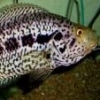Please fill out as much as possible below and give us a description of what is wrong with your fish.
Type of fish: flowerhorn
Symptoms: possible hexmita
Other tank mates: none
Tank size / capacity: 215 ltrs
Type of Food fed: none atm
Feeding frequency/amount: none atm
Substrate: gravel
Type of filtration: aqua one 1000 filter
Frequency of filter cleans: 10% every 1-2 days
Frequency and % volume of water changes:
Last water change: yesterday
PH: 7.8
KH: 5
GH: not sure
Nitrite: 20
Nitrate: 0.0
Ammonia: 0.0
Phosphate: not sure
Water temp:
Medications used recently to date:
Any recent changes..new fish/filters/power outages etc etc:
i bought some intertinal hexmita clear and internal parasite clear from aquatix because my flowerhorn may have hex or parasites as he has stringy poop now the lady said you can use both at the same time which i though was alot off meds at once but there the experts now this morning all the water has gone cloudy its scary and im starting to wonder whats going on. they said it wont harm the filters but the strange thing is it didnt go cloudy when i put it in at around 11am only when i got up this morning, so is this normal any idears....thanks













